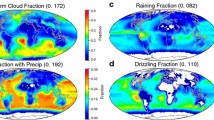Abstract
Two aspects of convection over oceans are discussed and the following conclusions are derived from theoretical considerations.
-
(1)
The air layer over the sea will usually convect even when the water surface is ten degrees or more colder than the initial air temperature.
-
(2)
An inversion at stratus cloud tops is created by the stratus, and is not a necessary preexisting condition. Such inversions persist after subsidence evaporates the cloud.
-
(3)
Radiation heat exchange does not play an essential role in stratus formation or maintenance, and can either heat or cool the cloud.
-
(4)
Dry air convection does not erode inversions at the top of the convecting layer. Examples of soundings are discussed.
-
(5)
Fogs are most likely to form at sea where the water is coolest, and need no radiation effects to initiate cooling, or a boost from patches of warmer water, to begin convection.
-
(6)
Both stratus cloud growth, and the evaporation of clouds by cloud top entrainment, readjust the vertical structure of the air to leave a constant wet-bulb potential temperature with height.
These conclusions are supported by, firstly, a convective model which has been developed and which shows that vapor-driven convection over the ocean will proceed with zero or negative heat fluxes, at rates which saturate the lowest layer of the atmosphere in a few hours to altitudes of many tens of meters. Secondly, the availability of condensed moisture at the top of the surface layer cools the warmer entrained overlying dry air parcels so that when they descend they are no warmer than the sea surface temperature, and this induces downward moving plumes. This occurs if the wet-bulb potential temperature of the overlying air is less than the sea surface temperature, even if it is ten degrees C, or more, warmer in actual temperature.
Similar content being viewed by others
References
Ball, F. K.: 1960, ‘Control of Inversion Height by Surface Heating’, Quart. J. Roy. Meteorol. Soc. 86, 483–494.
Chai, S. K.: 1978, ‘Lowering Stratus Cloud in Surface Driven Convection over the Sea’, Ph.D. Dissertation, Univ., of Nevada, Reno, 146 pp.
Chai, S. K. and Telford, J. W.: 1983, ‘Convection Model for Stratus Cloud over a Warm Water Surface’, Boundary-Layer Meteorol. 26, 25–49.
Deardorff, J. W.: 1980, ‘Cloud Top Entrainment Instability’, J. Atmos. Sci. 37, 131–147.
Deardorff, J. W.: 1983, ‘A Multi-Limit Mixed-Layer Entrainment Formulation’, Jour. Phys. Ocean. 13, 988–1002.
Guldberg, C. M. and Mohn, H.: 1876, ‘Etudes sur les mouvements de l'atmosphére’, Pt. 1 Christiania. 39 pp.
Lilly, D. K.: 1968, ‘Models of Cloud-Topped Mixed Layers Under a Strong Inversion’, Quart. J. R. Meteorol. Soc., 94, 292–309.
Manton, M. J.: 1980, ‘On the Modelling of Mixed Layers and Entrainment in Cumulus Clouds’, Boundary-Layer Meteorol. 19, 337–358.
Presley, J. D.: 1976, ‘Free Convective Plumes in the Atmosphere’, Ph.D. Dissertation, Univ. of Nevada-Reno, 162 pp.
Randall, D. A.: 1980a, ‘Entrainment into a Stratocumulus Layer with Distributed Radiative Cooling’, J. Atmos. Sci. 37, 148–159.
Randall, D. A.: 1980b, ‘Conditional Instability of the First Kind Upside-Down’, J. Atmos. Sci. 37, 125–130.
Saunders, P. M.: 1964, ‘Sea Smoke and Steam Fog’, Quart. J. Roy. Meteorol. Soc. 90, 156–165.
Smithsonian Meteorological Tables: 1966, Sixth Revised Edition, Smithsonian Miscellaneous Collections, Vol. 114, The Smithsonian Institution, 527 pp.
Squires, P.: 1958, ‘Penetrative Downdraughts in Cumuli’, Tellus 10, 381–389.
Telford, J. W.: 1966, ‘The Convective Mechanism in Clear Air’, J. Atmos. Sci. 23, 652–666.
Telford, J. W.: 1970, ‘Convective Plumes in a Convective Field’, J. Atmos. Sci. 27, 347–358.
Telford, J. W.: 1972, ‘A Plume Theory for the Convective Field in Clear Air’, J. Atmos. Sci. 29, 128–134.
Telford, J. W.: 1975, ‘The Effects of Compressibility and Dissipation Heating on Boundary Layer Plumes’, J. Atmos. Sci. 32, 108–115.
Telford, J. W.: 1981, ‘The Surface Roughness and Planetary Boundary Layer’, Pure Appl. Geophys. 119, 278–293.
Telford, J. W.: 1982, ‘A Theoretical Value for von Karman's Constant’, Pure Appl. Geophys. 120, 648–661.
Telford, J. W. and Warner, J.: 1962, ‘On the Measurement from an Aircraft of Buoyancy and Vertical Air Velocity in Cloud’, J. Atmos. Sci. 19, 415–423.
Telford, J. W. and Warner, J.: 1964, ‘Fluxes of Heat and Vapor in the Lower Atmosphere Derived from Aircraft Observations’, J. Atmos. Sci. 21, 539–548.
Telford, J. W. and Presley, J. D.: 1978, ‘The Surface Boundary Layer as a Part of the Overlying Convective Layer’, Pure Appl. Geophys. 117, 664–689.
Telford, J. W. and Wagner, P. B.: 1981, ‘Observations of Condensation Growth Determined by Entity Type Mixing’, Pure Appl. Geophys. 119, 934–965.
Telford, J. W. and Chai, S. K.: 1982, ‘Fog, Stratus and Cumulus Formation in Warm Air over Cooler Water’, Preprints of the Conference on Cloud Physics, November 15–18, 1982, Chicago, Illinois, 7–8.
Telford, J. W. and Keck, T. S.: 1984, ‘Inversions, Entrainment into Clouds, and Invariance of the Wet Bulb Potential Temperature with Height’, submitted for publication.
Telford, J. W., Vaziri, A., and Wagner, P. B.: 1976, ‘Aircraft Observations in the Planetary Boundary Layer under Stable Conditions’, Boundary-Layer Meteorol. 10, 353–377.
Twomey, S.: 1983, ‘Radiative Effects in California Stratus’, Contrib. Atmos. Phys. 56, 429–439.
Warner, J. and Telford, J. W.: 1963, ‘Some Patterns of Convection in the Lower Atmosphere’, J. Atmos. Sci. 20, 313–318.
Warner, J. and Telford, J. W.: 1967, ‘Convection Below Cloud Base’, J. Atmos. Sci. 24, 374–382.
Woodcock, A. H.: 1982, ‘Fog, and Tidal Current Connection at Cape Cod Canal — Early Recognition and Recent Measurements’, Bull. Am. Meteorol. Soc. 63, 161–166.
Author information
Authors and Affiliations
Rights and permissions
About this article
Cite this article
Telford, J.W., Chai, S.K. Inversions, and fog, stratus and cumulus formation in warm air over cooler water. Boundary-Layer Meteorol 29, 109–137 (1984). https://doi.org/10.1007/BF00206826
Accepted:
Issue Date:
DOI: https://doi.org/10.1007/BF00206826




